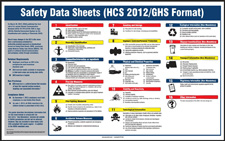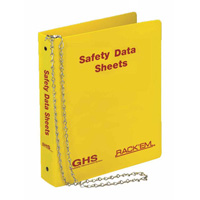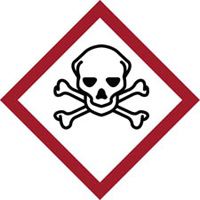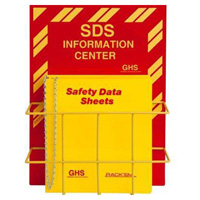| The Home page of ILPI's Safety Data Sheet (SDS) Resource, the leader in SDS information since 1995! | |
| The history and philosophy behind this resource. | |
| A curated collection of books and reference materials concerning Safety Data Sheets and closely related topics. | |
| Paste your plain text SDS into the SDS-Demystifier, and it will be converted into a hypertext-enriched document with links to detailed explanations of each key term. | |
| An extensive list of frequently asked questions about Safety Data Sheets including regulations, content, compliance, and more. | |
| A humorous take on Safety Data Sheet jargon. Fill in the blanks on our entry form to generate a personalized Unsafety Data Sheet to share with your coworkers. | |
| Since 1995, we've maintained this massive curated list of the best places to find Safety Data Sheets on the Internet. | |
| You are here! Way more than a glossary, this hypertext-enhanced resource covers hundreds of SDS-related terms and expert knowledge. Each entry includes both the SDS relevance and links to additional authoritative resources. | |
| Archived results of Safety Data Sheet related polls taken by some of our millions of site visitors | |
| The OSHA regulations behind SDS regulations, including the inspection guidelines and over 400 official interpretations letters under the Hazard Communication Standard | |
| Commercial suppliers of SDS authoring and management software as well as cloud compliance services. | |
| Commercial companies that will create SDS's for your specific needs as well as SDS translation companies. |

Safety signs, banners, and scoreboards? Get yours at Safety Emporium!
Definition
The Globally Harmonized System of Classification and Labeling of Chemicals (GHS) is an international consensus system developed by the United Nations for classifying and labeling hazardous chemicals. The GHS is designed to streamline the hazard assessment, labeling, and hazard communication requirements within and between the countries that adopt it by promoting common, consistent criteria for classifying chemicals according to their health, physical and environmental hazards, and to develop compatible labeling, safety data sheets (SDS's; formerly known as MSDS's) and other information based on those classifications.
GHS resolves many, but not all, differences between (M)SDS's and labels between, for example, the US, Canada, and the European Union.
OSHA adopted many (but not all) GHS Revision 3 principles in its most recent update to 29 CFR 1910.1200, the OSHA Hazard Communication Standard. Implementation of HCS 2012 was phased in and took full effect in 2016. The previous version, HCS 1994, is no longer in force.
Additional Info
US Rulemaking

Ensure your workers are trained with safety posters and more at Safety Emporium.
The first regulatory movement towards adapting elements of US OSHA requirements to the GHS began with an Advanced Notice of Proposed Rulemaking (ANPR) on September 12, 2006. A 60 day comment period received over 100 written and electronic comments which generally supported adoption and highlighted the need for harmonization in how chemicals and their hazards are classified in a worldwide marketplace.
On September 30, 2009, OSHA published its proposed rulemaking to incorporate changes per the GHS (US Federal Register 74:50279-50549). You can view this document in HTML on OSHA's web site or download it as PDF file from the US Government Printing Office. The Public Comment period ended December 29, 2009 and gathered several hundred written comments that are available here.
On October 25, 2011, OSHA submitted the final rule to OMB which finished its review on February 21, 2012. On March 20, 2012, OSHA published its Final Rule establishing HCS 2012, which included a phased in series of effective dates which were:
| Effective Date | Requirement(s) | Who |
|---|---|---|
| December 1, 2013 | Train employees on the new label elements and safety data sheet (SDS) format. | Employers |
| June 1, 2015 | Compliance with all modified provisions of this final rule. | Chemical manufacturers, importers and employers |
| December 1, 2015 | The distributor must not ship containers labeled by the chemical manufacturer or importer unless it is a Hazard Communication standard (HCS) 2012 label. | Distributors* |
| June 1, 2016 | Update alternative workplace labeling and hazard communication program as necessary, and provide additional employee training for newly identified physical or health hazards. | Employers |
| Transition Period May 26, 2013 - June 1, 2016 |
May comply with either HCS 2012 or the previous version (HCS 1994), or both. | Chemical manufacturers, importers, distributors, and employers |
| * If the distributors meet the definition of manufacturers (see section X.C. of OSHA Directive Number CPL 02-02-079), which includes repackaging and relabeling the chemicals, they must comply by June 1, 2015. | ||
It is critical to recognize that HCS 2012 is based on Revision 3 of the GHS. The GHS is updated on an ongoing basis. In 2021, UNECE published Revision 9 which introduced a significant number of changes that will probably not make their way into US regulations for many years.
On February 5, 2021, OSHA issued a proposed rule to update the HCS to align with 2017 Revison 7 of the GHS. The public comment period for this proposal ran February 16 through May 19, 2021. The proposed changes are listed under Docket No. OSHA-2019-0001 and include revised criteria for classification of certain health and physical hazards, revised provisions for updating labels, new labeling provisions for small containers, technical amendments related to the contents of Safety Data Sheets, and related revisions to definitions of terms used in the standard. It appears that OSHA is currently targeting March 2023 for implementation as a Final Rule.
Impact

Get your SDS binders, centers and more from Safety Emporium.
As stated above, GHS is a model standard and implementation from country to country will vary. For example, OSHA's HCS currently covers acute toxicity with respect to (M)SDSs. The GHS's coverage of acute toxicity is quite broad, covering consumer protection in addition to occupational concerns. As OSHA has no regulatory authority for consumer issues/products, the HCS will never be able to incorporate all the changes to acute toxicity that the GHS suggests. This does not stop other Federal agencies such as the Consumer Product Safety Commission from enacting such legislation under their own purview, however.
Other US agencies affected by the GHS include:
- The US Department of Transportation's Pipeline and Hazardous Materials Safety Administration has an article on Global Harmonization of Hazard Classification and Labeling Systems.
- The US Environmental Protection Agency has a web site on Pesticide Labels and GHS: Comparison and Samples.
In the European Union (EU), Safety Data Sheets (SDS) and labels issued prior to June 1, 2015 were required to use a uniform coding system of risk phrases and safety phrases to communicate risks and precautions. The phrases are accompanied by numbers so the phrases can be easily translated or understood in multiple languages. The GHS takes a similar approach but risk phrases and safety phrases have been replaced(see Annex 3 Section 1). Risk phrases have become Hazard Statements ("H-statements") and safety phrases are now Precautionary Statements ("P-statements"). The EU transition required modifications and additions to the existing R- and S-phrases and introduced a new numbering system for the P- and H-statements. Note: regardless of system, phrases must always be written out in words; the numbers are provided as a reference only and should never be used as a substitute for the full phrases.
A sampling of GHS resources for other countries includes:
- European Union Classification and Labelling (CLP/GHS) considerations - https://single-market-economy.ec.europa.eu/sectors/chemicals/classification-and-labelling-clpghs_en.
- Canada: WHMIS 2015 - https://www.canada.ca/en/health-canada/services/environmental-workplace-health/occupational-health-safety/workplace-hazardous-materials-information-system.html.
- Taiwan: Latest News of GHS in Taiwan - http://ghs.osha.gov.tw/ENG/intro/news.aspx.
- Japan: GHS Information - https://www.nite.go.jp/chem/english/ghs/ghs_index.html.
A detailed implementation list for 72 countries is available at https://unece.org/ghs-implementation-0.
A 2021 article from ACS Chem Health Saf. titled GHS Implementation to Strengthen Global Chemical Hazard Communication: Will We Ever Get There? discusses the challenges of worldwide implementation of the GHS, including the use of different data sets for hazard classification.
SDS Relevance
The major changes under HCS 2012 versus the old standard are:
- "Hazard determination" is replaced by rigorous hazard classification under which chemical manufacturers and importers are required to determine the hazards of the chemicals they produce or import. Very specific and new criteria are used to address health and physical hazards as well as the classification of chemical mixtures.
- Labels now require a signal word, one or more pictograms, hazard statements, and precautionary statements for each hazard class and category.
- Material Safety Data Sheets (MSDS's) are now referred to more simply as Safety Data Sheets (SDS's). They now have a specific 16 section format that ensures a consistent presentation of important protection information. As you receive new SDS's in your workplace, you simply replace the old MSDS's the way you always have. There is no need to seek out an SDS for a chemical you already have on hand however your workers must be trained on both the older and new labeling and SDS systems, of course.
- Information and training requirements are in force as of December 1, 2013 and require that all workers have been trained in the new label elements and new safety data sheet formats in addition to their regular training requirements of updating hazard communication as new hazards are identified.

Get your GHS-compliant labels and signs from Safety Emporium.
A comparison of the 1994 and 2012 HCS is available which strikes out the old language in red, inserts new language in green, and has additional commentary on each section.
Finally, as mentioned above, OSHA lacks jurisdiction over several areas that the GHS addresses. Therefore, while the new SDS format includes the following new sections:
- 12. Ecological information
- 13. Disposal considerations
- 14. Transport information
- 15. Regulatory information
these sections are "non-mandatory". OSHA requires only that these headings appear on the sheet but do not require that any information be entered under sections 12 through 15.
Further Reading
- OSHA resources:
- Small Entity Compliance Guide for Employers That Use Hazardous Chemicals.
- OSHA Brief: Hazard Communication Standard: Safety Data Sheets
- OSHA Brief: Hazard Communication Standard: Labels and Pictograms
- OSHA Fact Sheet: December 1st, 2013 Training Requirements for the Revised Hazard Communication Standard
- Hazard Communication Quick Cards on SDS, labeling, and pictograms
- UNECE resources:
- Status of GHS Implementation by country.
- GHS presentations.
- Full text of the GHS Revision 9 (2021) including the Annexes which discuss required classification and labeling. Revision 3, the basis of HCS 2012, is also available.
- GHS guidance provides links to technical resources to assist in classification and understanding of the model standard.
- Globally Harmonized System (GHS) for Classification and Labelling of Chemicals at the US EPA.
- GHS Classification summary at the US NIH.
- Chemical Hazard Classification (GHS) at the U of Illinois Division of Research Safety.
- Globally Harmonized System at MilliporeSigma (Sigma-Aldrich), a major chemical supplier, includes some nice timeline and country data.

Your employees can stay informed and comply with OSHA regulations with SDS information stations and compliance products from Safety Emporium.
See also: ACGIH, ANSI, CFR, Hazard Statements, Precautionary Statements, risk phrases, safety phrases, UN/NA Numbers.